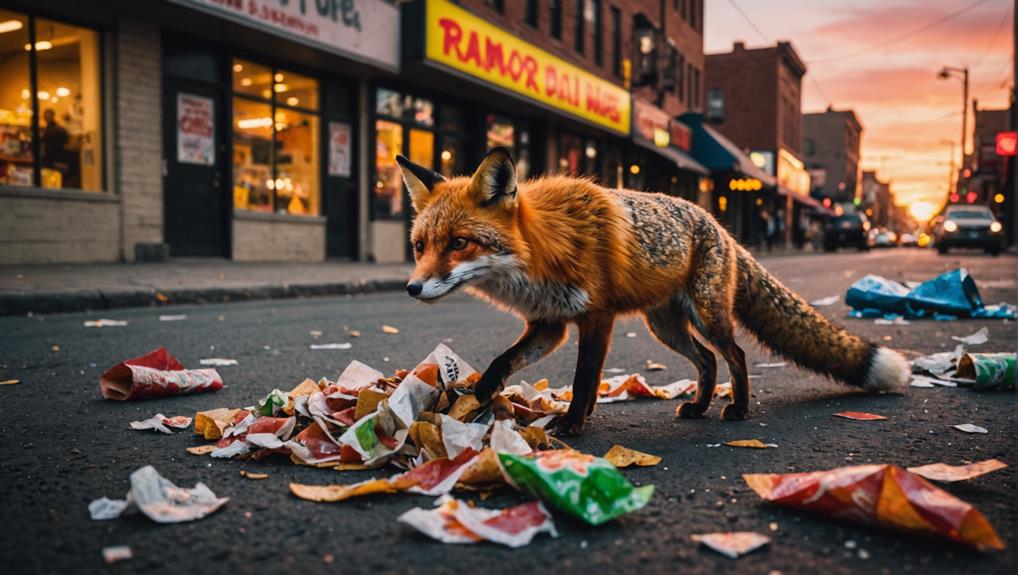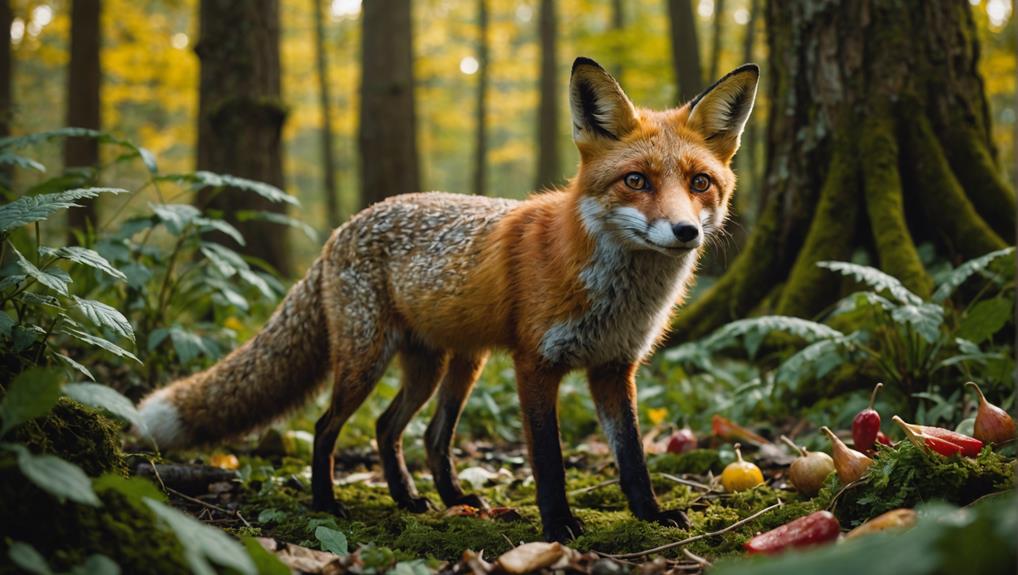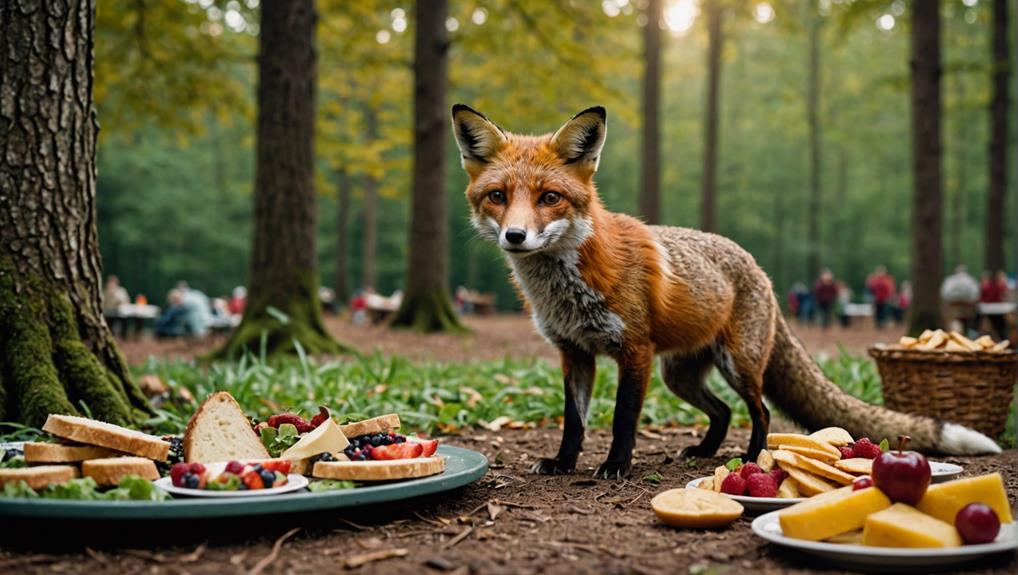Human food has a big impact on a fox's diet, especially in urban areas. You see, these clever creatures have adapted quite well to city life, relying on our leftovers for about 18% of their meals! Instead of hunting, they're more likely to scavenge, making human waste about half of what they eat. This change in diet can affect their health and how they compete with other animals. It's pretty fascinating how a pizza slice or a hot dog can shape their world, isn't it? Stick around, and you'll uncover even more about how their fluffy lives intertwine with ours!
Contents
Overview of Fox Diet
When it comes to their diet, red foxes are versatile and opportunistic feeders. They don't stick to just one type of food; instead, their diverse diet includes small to medium-sized mammals like rodents and rabbits, along with birds, insects, and even some plant matter. You'd be surprised how adaptable these little critters are!
In urban environments, they often undergo a dietary shift, relying more on human food waste, which surprisingly makes up about 18% of their meals. This dietary flexibility is vital for urban foxes, as they scavenge through trash and adapt to the available food sources, demonstrating significant urban adaptation and population growth.
Prey availability also plays a big role in what foxes munch on. In spring and summer, they've got a buffet of food sources, but come winter, they might've to dig through trash bins or scavenge more due to fewer critters around. Foxes in northern climates tend to feast more on rodents, while their city cousins might snack on extra rabbits.
On average, a wild fox needs about 400 grams of food each night, which is a hefty 10% of its body weight. So, next time you spot a fox, just know it's probably on the hunt for its next meal, be it a mouse or a leftover slice of pizza!
Historical Dietary Changes
You might be surprised to learn how much foxes' diets changed over time, especially with the arrival of early humans.
Instead of just hunting small mammals, these clever critters started scavenging for leftovers from our prehistoric feasts, like mammoth bones and reindeer scraps.
As human settlements popped up, foxes adapted their eating habits, proving they're not just survivors, but savvy diners who know how to make the most of the buffet!
Paleolithic Dietary Shifts
Shifting dietary habits among foxes during the Upper Paleolithic era highlight the significant impact of human activity on wildlife. As humans increased their presence in southwestern Germany around 40,000 years ago, fox diets changed dramatically. They went from primarily hunting small mammals to scavenging human leftovers, showcasing a fascinating adaptation to their environment.
| Fox Diets Changes | Before Human Influence | After Human Influence |
|---|---|---|
| Main Food Source | Small mammals | Human leftovers |
| Scavenging Behavior | Rarely scavenged | Frequently scavenged remains |
| Archaeological Evidence | Limited to animal bones | Increased remains of large animals |
| Isotope Analysis Result | Low reliance on humans | High reliance on human food |
This shift is backed by isotope analysis of fox remains, which shows they increasingly relied on discarded food. These findings underline how foxes acted as ecological indicators, reflecting the profound impacts of human habitation on local ecosystems. So next time you see a fox rummaging around, just think—its diet has come a long way, thanks to our human habits!
Urban Adaptation Strategies
Urban foxes have developed remarkable adaptation strategies in response to the challenges of city life, substantially altering their diets over time. These clever critters have become masters of opportunistic feeding, relying heavily on human food scraps. In fact, studies show that about 45% of their diets in urban areas consist of non-natural food sources, compared to just 5% for their rural cousins. This impressive shift demonstrates how foxes can thrive amidst urban challenges, such as habitat loss and fragmentation.
As urban areas grow, foxes have shifted their dietary habits, turning to scavenging for leftovers from our meals. Household scraps and pet food make up nearly 18% of their diet! This change highlights their resilience and ability to adapt to environmental changes.
When natural food sources become scarce, these foxes cleverly forage for whatever they can find to meet their nutritional needs. Their adaptability isn't just about survival; it's a proof of their resourcefulness.
Urban foxes have turned the city into their buffet, proving that they can thrive in a human-dominated world. So, next time you see a fox rummaging through your trash, remember, it's just a little scavenger making the most of its urban lifestyle!
Impact of Human Waste

When you think about urban foxes, it's hard not to notice how they've switched things up in their diets. Instead of hunting like their rural cousins, they've become expert scavengers, relying heavily on our discarded food.
This shift to munching on human waste not only shows their incredible adaptability but also raises questions about how this affects their health and well-being. Urban foxes often thrive in gardens, parks, and green spaces, showcasing their ability to coexist with humans in densely populated areas.
Their diet, which consists of 50% meat and 50% household refuse, highlights their opportunistic feeding behavior and reliance on urban food sources to survive.
Urban Food Sources
Many city-dwelling foxes have adapted their diets to take advantage of the abundant food waste produced by humans.
In fact, these clever urban foxes rely on human food for up to 18% of their diet! Unlike their rural cousins, who feast mainly on natural prey, urban foxes get about 45% of their nutrition from discarded scraps like household waste and pet food.
Living in populated areas means they've learned to forage effectively. You might see them rummaging through trash bins or sneaking around backyards, all in search of tasty leftovers.
Seasonal changes also play a role in their foraging behaviors. For instance, during holidays, when people tend to throw out more food, foxes have a feast—talk about a holiday bonus!
This remarkable adaptation shows just how resourceful these foxes can be. They thrive in environments shaped by human activity, turning our waste into their meals.
Scavenging Behavior Adaptation
Foxes have shown remarkable adaptability in their scavenging behavior, particularly in response to the abundance of human waste. As red foxes roam urban areas, they've shifted their diets from hunting small mammals to scavenging discarded food. This clever adaptation allows them to thrive where natural prey might be scarce.
You might be surprised to learn that urban foxes get about 45% of their diet from food waste, while their rural cousins rely on a hefty 95% of meat from natural prey.
This scavenging behavior really highlights how human behavior affects wildlife. In fact, archaeological evidence shows that foxes have been munching on leftovers from large animals, like mammoths and reindeer, since the Upper Paleolithic era.
Urban vs. Rural Diets
The stark contrast between urban and rural diets highlights the adaptability of foxes in response to their environments. Urban foxes rely on human food for about 45% of their diet, while rural foxes stick to natural prey, which makes up over 95% of theirs.
You might say urban foxes are the ultimate scavengers, rummaging through food waste and scraps, which account for around 18% of their meals. It's a bit like a furry dumpster dive!
In rural areas, foxes focus on hunting small mammals and birds, showing off their skills in the wild. But in cities, they've turned their opportunistic nature into an art form. With less natural prey available due to increased human activity, these clever critters have adapted by foraging for discarded human food items instead.
This shift in diet is a fascinating example of adaptation. Urban foxes thrive on easily accessible resources, proving that even in a concrete jungle, they can find a way to survive.
Ecological Implications

Shifts in diet from natural prey to human food reveal significant ecological implications for fox populations. In urban environments, foxes are snacking more on human scraps, with studies showing that these leftovers can make up to 18% of their diet. This change might seem harmless, but it disrupts the natural food web. Instead of hunting, foxes start scavenging, which can affect their hunting skills over time.
Archaeological evidence shows that as humans expanded, foxes adapted their diets to include large prey remains, like mammoth and reindeer.
Today's foxes are just following that trend, but instead of ancient beasts, they're noshing on your leftover pizza. This shift makes foxes crucial ecological indicators, reflecting changes in resource availability and habitat due to human presence.
Consequently, you might see altered population dynamics in local wildlife. When foxes change their eating habits, it can affect other species too.
To tackle these challenges, we need conservation strategies that consider the impact of human food on these clever critters. After all, we all share this planet, and keeping the balance is essential—no one wants a world where foxes prefer takeout over a good old-fashioned hunt!
Future Research Directions
How do changing diets impact the future of fox populations? Well, future research is vital to understanding this complex relationship. As urbanization continues, we need to investigate how increased human food availability affects fox diets and their foraging strategies.
Using enhanced isotopic analysis of fox scat can help reveal the balance between human food and natural prey over time. This knowledge could shed light on dietary changes and adaptability in different environments.
Moreover, it's important to explore the health implications of foxes munching on human-derived foods. Are they facing potential toxicity or nutritional deficiencies compared to their natural diets? Understanding these aspects can help us determine how to better support wildlife conservation efforts.
Let's not forget the impact of fox-human interactions! By studying how human food sources affect reproductive success and survival rates, we can gather valuable data that informs our conservation strategies.
Ultimately, by addressing these questions, we can help secure the future of fox populations remains bright, even in a world filled with fast food wrappers and takeout containers. Who knew our leftovers could be a part of such a wild story?
Final Thoughts
In summary, the way humans impact a fox's diet is pretty fascinating. Did you know that in urban areas, about 30% of a fox's food comes from human waste? This shows just how adaptable these clever creatures are! While it's great to see them thrive, it also raises concerns about their health and the environment. So next time you spot a fox scavenging, remember: they're not just cute; they're also steering through a changing world thanks to us!














